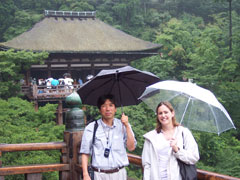Turning Japanese
By Laura Pratt
It was June 13, 2006, her first day in Tokyo, and Dr. Alison Burgess might as well have been on the moon. Burgess, then a PhD student freshly launched on an academic exchange to Japan, was taking the subway back to her apartment. It was packed, the foreign chatter inside it an inscrutable buzz. Then, suddenly, an announcement blasted over the station's sound system, and everybody started running. Burgess ran, too, convinced the place must be in flames. But it soon became apparent that the rampage was in response to something less dramatic: an announcement that the next train had arrived.
Not as culturally confusing was Burgess's reception of the science she had traveled overseas to study. In a unique arrangement facilitated by a joint program between the Canadian Institutes of Health Research and the Japanese Society for the Promotion of Science, Burgess had landed in Japan for 10 weeks to extend the research she was pursuing under the supervision of Dr. Isabelle Aubert, a scientist in clinical integrative biology who studies neuronal plasticity during brain development, adulthood and aging at Sunnybrook Research Institute (SRI).
Specifically, Burgess was looking at the development of neurons and their transformation into particular types of cells.
Historically, brain scientists didn't believe that new nerve cells are born in the adult brain. "Adult neurogenesis" was discovered by Joseph Altman in 1965. Unfortunately, says Dr. Tatsunori Seki, who served as Burgess's supervisor in Tokyo, "the discovery was ignored for more than 30 years." It was the late 1990s before the scene changed, and Seki contributed to it by demonstrating that new nerve cells in the adult brain specifically express a large sugar molecule called polysialic acid.
But the importance of this groundbreaking news, says Aubert, was not then recognizedby the larger neuroscience community. It suffered the same fate later, when Seki gave a presentation at an international meeting in 1998. In 2007 at a conference in Germany, Aubert remembers, Seki told the crowd, "None of you paid attention in 1998. Would you believe me now that this is important?" This time, the world heard what Seki had to say. Now, the reality of lifelong birth of new brain cells in specific areas of the adult brain is widely accepted.
Burgess and Aubert found that removing polysialic acid from embryonic neurons increase some of their neuronal characteristics. Based on these findings, they both wondered whether removing polysialic acid on newborn cells of the adult brain would trigger neuronal maturation. They came to the same conclusion: "If we want to find out," they said to each other, "we need Dr. Seki on our team."
In the fall of 2005, Aubert and Burgess wrote a studentship application to fund Burgess's trip to Japan. When it was approved, says Aubert, fellow PIs told her she was crazy to release her best student to this Japanese adventure. "But I believed in her. I completely trusted that she would go there and work like crazy with Dr. Seki, who's like a kid in a candy store when it comes to scientific research."
Curious to discover how cells behave when they're deprived of polysialic acid, and how scientists can work with this isolation to induce certain behaviour, Burgess and Seki injected an enzyme (prepared by a New York researcher, Dr. Urs Rutishauser, for just such a purpose) into the brain that strips the acid from the cell. Together, they were able to demonstrate that certain cells, absent of polysialic acid, organize themselves in clusters and can be instructed to become mature neurons. Their findings were published in December 2008 in the journal Developmental Neurobiology.
The Japanese jaunt proved a jumping-off point for Burgess to the next stage of her professional life. When she presented the results of this work at a conference in Germany in March 2007, she made the acquaintance of a scientist who was studying polysialic acid. When she was closer to graduating, this scientist hired Burgess as a research associate, in neuroglycomics, with the National Research Council, in Ottawa. "One thing led to another," says Burgess. "It's nice when that happens."
For her part, Aubert is delighted with the results. "I've tried other collaborative projects abroad before, but they didn't get funded. I'm so pleased with this collaboration. I hope there's a mechanism where we can keep this going."
PDF / View full media release »





